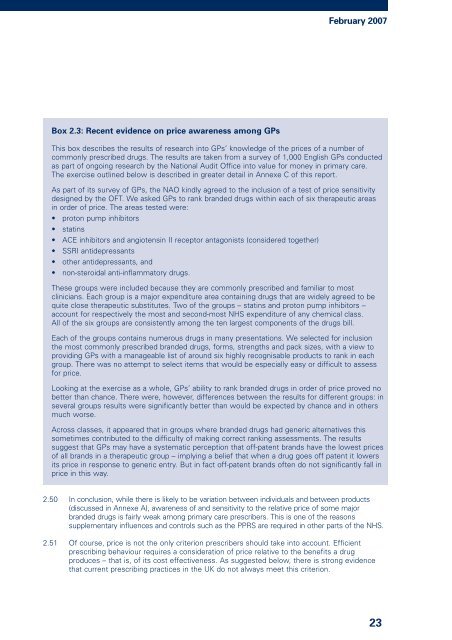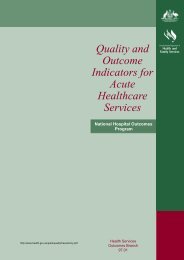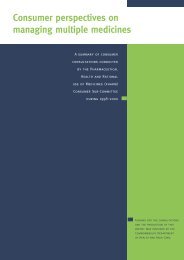The Pharmaceutical Price Regulation Scheme - Office of Fair Trading
The Pharmaceutical Price Regulation Scheme - Office of Fair Trading
The Pharmaceutical Price Regulation Scheme - Office of Fair Trading
Create successful ePaper yourself
Turn your PDF publications into a flip-book with our unique Google optimized e-Paper software.
February 2007<br />
Box 2.3: Recent evidence on price awareness among GPs<br />
This box describes the results <strong>of</strong> research into GPs’ knowledge <strong>of</strong> the prices <strong>of</strong> a number <strong>of</strong><br />
commonly prescribed drugs. <strong>The</strong> results are taken from a survey <strong>of</strong> 1,000 English GPs conducted<br />
as part <strong>of</strong> ongoing research by the National Audit <strong>Office</strong> into value for money in primary care.<br />
<strong>The</strong> exercise outlined below is described in greater detail in Annexe C <strong>of</strong> this report.<br />
As part <strong>of</strong> its survey <strong>of</strong> GPs, the NAO kindly agreed to the inclusion <strong>of</strong> a test <strong>of</strong> price sensitivity<br />
designed by the OFT. We asked GPs to rank branded drugs within each <strong>of</strong> six therapeutic areas<br />
in order <strong>of</strong> price. <strong>The</strong> areas tested were:<br />
• proton pump inhibitors<br />
• statins<br />
• ACE inhibitors and angiotensin II receptor antagonists (considered together)<br />
• SSRI antidepressants<br />
• other antidepressants, and<br />
• non-steroidal anti-inflammatory drugs.<br />
<strong>The</strong>se groups were included because they are commonly prescribed and familiar to most<br />
clinicians. Each group is a major expenditure area containing drugs that are widely agreed to be<br />
quite close therapeutic substitutes. Two <strong>of</strong> the groups – statins and proton pump inhibitors –<br />
account for respectively the most and second-most NHS expenditure <strong>of</strong> any chemical class.<br />
All <strong>of</strong> the six groups are consistently among the ten largest components <strong>of</strong> the drugs bill.<br />
Each <strong>of</strong> the groups contains numerous drugs in many presentations. We selected for inclusion<br />
the most commonly prescribed branded drugs, forms, strengths and pack sizes, with a view to<br />
providing GPs with a manageable list <strong>of</strong> around six highly recognisable products to rank in each<br />
group. <strong>The</strong>re was no attempt to select items that would be especially easy or difficult to assess<br />
for price.<br />
Looking at the exercise as a whole, GPs’ ability to rank branded drugs in order <strong>of</strong> price proved no<br />
better than chance. <strong>The</strong>re were, however, differences between the results for different groups: in<br />
several groups results were significantly better than would be expected by chance and in others<br />
much worse.<br />
Across classes, it appeared that in groups where branded drugs had generic alternatives this<br />
sometimes contributed to the difficulty <strong>of</strong> making correct ranking assessments. <strong>The</strong> results<br />
suggest that GPs may have a systematic perception that <strong>of</strong>f-patent brands have the lowest prices<br />
<strong>of</strong> all brands in a therapeutic group – implying a belief that when a drug goes <strong>of</strong>f patent it lowers<br />
its price in response to generic entry. But in fact <strong>of</strong>f-patent brands <strong>of</strong>ten do not significantly fall in<br />
price in this way.<br />
2.50 In conclusion, while there is likely to be variation between individuals and between products<br />
(discussed in Annexe A), awareness <strong>of</strong> and sensitivity to the relative price <strong>of</strong> some major<br />
branded drugs is fairly weak among primary care prescribers. This is one <strong>of</strong> the reasons<br />
supplementary influences and controls such as the PPRS are required in other parts <strong>of</strong> the NHS.<br />
2.51 Of course, price is not the only criterion prescribers should take into account. Efficient<br />
prescribing behaviour requires a consideration <strong>of</strong> price relative to the benefits a drug<br />
produces – that is, <strong>of</strong> its cost effectiveness. As suggested below, there is strong evidence<br />
that current prescribing practices in the UK do not always meet this criterion.<br />
23




